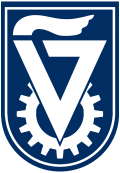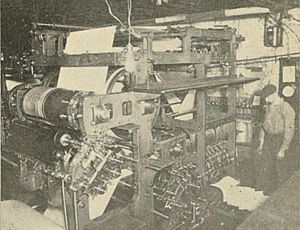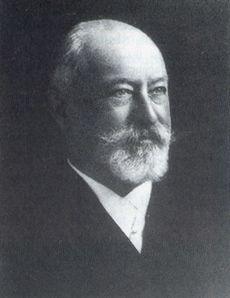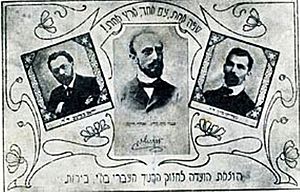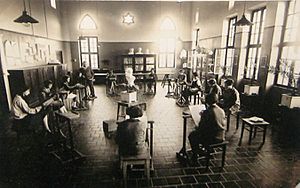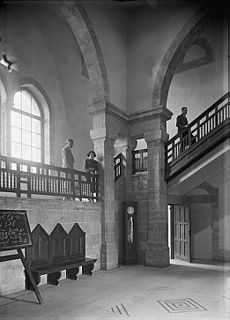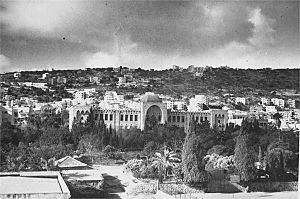History of the Technion – Israel Institute of Technology facts for kids

The Technion – Israel Institute of Technology is a top university for science and technology in Haifa, Israel. It has a long and interesting history, starting way back in the early 1900s. It has played a huge role in building modern Israel.
Contents
How Technion Began
Technion was created 36 years before Israel became an independent country. It helped train engineers and provided the knowledge needed to build important things like electricity, water systems, and roads. These were the basic building blocks for a modern nation.
Since its first cornerstone was laid in 1912, Technion has always looked ahead. It aimed to meet future needs to help Israel survive and grow. One journalist said that Technion's story is a great example for other groups trying to create their own independent nations. Technion helped lay the groundwork for Israel to become a leader in science and technology.
Technion grew quickly and became a world leader in many fields. These include biotechnology (using living systems for technology), satellite research, computer science, nanotechnology (working with tiny materials), and energy studies.
In 2004, Technion professors won Israel's first Nobel Prizes in science. Then, in 2011, Professor Dan Shechtman won another Nobel Prize in Chemistry. He discovered something new called quasicrystals, also known as "Shechtmanite." By 2012, Technion City was a busy place for research and teaching. It had 12,850 students and 80 different study programs for advanced degrees. In 2011, Technion even teamed up with Cornell University to create a new innovation institute in New York City.
Early Ideas for a University
The Zionist movement, which aimed to create a Jewish homeland, always dreamed of having a Jewish university in Israel. At the time, Jewish people often faced barriers to getting technical or scientific training. Without engineers and scientists, the dream of building a nation would be impossible.
In 1902, Theodor Herzl, an important Zionist leader, imagined Haifa as a beautiful city with modern technology. He saw it as a place of great homes and public buildings, all made possible by science and engineering. This idea gave the Zionist movement a practical goal. By 1901, there was strong pressure to start cultural institutions, and a plan was made to explore creating a Jewish university.
Three young men – Martin Buber, Berthold Feiwel, and Chaim Weizmann – pushed for a Jewish university that focused on technology. They pointed out how hard it was for Jewish youth to get into universities, especially for technical studies. They believed that a lack of technical skills kept Jewish people from many jobs and pushed them into other areas.
Their plan was to create a "Technikum," a technical school. This school would train students for the university and also teach young people technical, agricultural, and similar skills. Graduates from this school would help build and maintain Jewish industries.
In 1903, the Jewish community in Palestine held its first national assembly. This was an early step towards Jewish self-government. During this meeting, Zionist leader Menahem Ussishkin spoke about the urgent need for a higher education institution in Palestine. The assembly supported the idea of a polytechnical institute, and so, the Technion was born, at least on paper!
Paul Nathan, from a German Jewish relief organization, helped bring different Jewish groups together to support the Technikum and raise money.
First Donations
A wealthy Russian tea merchant named Kalonymous Zeev Wissotzky left a lot of money (about 1 million rubles) for charity. One of the people in charge of his will was Ahad Ha-Am, a famous Zionist thinker. Ahad Ha-Am convinced Wissotzky's son, David, to support the Technikum plan. This led to a first donation of 100,000 rubles.
In 1908, American philanthropist Jacob Schiff visited the "holy land." He was moved by the poverty he saw among many Jewish people in Palestine. He was inspired by the idea of a school that would provide technical training.
Back in Europe, people remained very interested in the new Technikum. In 1909, Dr. Chaim Weizmann, who later became the President of the State of Israel, reported that things were going well. Rich Jewish people from many countries were promising to give generous support.
Why Haifa Was Chosen
The Jewish community in Jerusalem wanted the Technikum to be built there. They even set up a special committee to argue for Jerusalem. However, the arguments for Haifa were stronger, and Haifa was chosen:
- Haifa was seen as the city of the future. It was expected to become a major port and a center for industry and shipping. With the Hedjaz railroad connecting it to Damascus and Baghdad, it would also be an important hub for land travel.
- The local Jewish community in Haifa was not as strict or set in its ways as Jerusalem, which was a center for Orthodox Judaism. Jaffa was known for Jewish nationalism. Haifa's neutral atmosphere was thought to help avoid conflicts.
- The Jewish community in Haifa was small, so the Technikum would help the Jewish population in the North grow and expand.
1912: The First Cornerstone
In October 1909, Prussian architect Alexander Baerwald was asked to design the new building. This architect, who used to play music with Albert Einstein, wanted to mix European style with Eastern elements. His amazing design was approved. In August 1910, Baerwald was given the job of drawing detailed plans and overseeing the building work. Most of the building materials, except for the stone, came from other countries. The lime was from France, and the cement was from Germany. Even the plumbing and other parts came from Europe. Today, visitors to the old building can still see German company names on the floor and other places.
Digging a well for water also caused problems. Early attempts only reached 40 meters, and work stopped because there weren't enough skilled workers. A special permit was needed to bring in dynamite. Finally, a foreign expert was brought in, and water was found at 93 meters. The well was deepened to 100 meters. Having a water source on Mount Carmel changed Haifa. It became a vital source of life for decades and for three different armies that invaded the area. The well and its water also became an important way for the young, struggling Technikum to earn money.
In 1912, the same year the Titanic sank, the cornerstone of the new Technikum was finally laid. On April 11, 1912, 36 years before Israel became independent, the local Jewish community gathered to see the dream of decades finally start to become real. This happened under the rule of the Ottoman Empire.
The "War of the Languages"

There was a big disagreement between the Hilfsverein (a global education group led by German Jews) and the Zionist movement. This conflict was about what language should be used for teaching at the Technikum, and it was called the "War of the Languages." Modern Hebrew was still very new, and there were no technical education materials in the biblical language. Many argued that German should be used. Some suggested English as a compromise. It was only after World War I and Germany's reduced influence in Palestine that Hebrew was finally chosen as the official language for Technion, and later for the State of Israel.
Albert Einstein and Other Supporters

Albert Einstein felt it was important to support technical and scientific opportunities for Jewish people, especially at the new Technikum in Palestine. He said that "The development of Palestine is truly very important for all Jewish people."
In 1923, Einstein visited Technion. During his visit, he planted a famous palm tree, which still stands today in front of the old Technion building. Einstein later went back to Germany and helped set up the first Technion Society, serving as its chairman. He also traveled to America to raise money for higher education in Palestine, a cause he said was "close to his heart." Einstein's reason for helping was not about nationalism, but about helping people. He said, "I do what I can to help those in my tribe who are treated so badly everywhere."
First Classes
Arthur Blok, an electrical engineer, was Technion's first President from 1924 to 1925. Technion welcomed its first students in 1924, and its official opening ceremony was in 1925. The first class had 17 students, including one woman. They studied civil engineering and architecture. After Blok, other presidents included Max Hecker (1925–27), Shmuel Pewsner (1927–29), Aharon Tcherniavsky (1927–29), and Joseph Breuer (1930–31).
World War II and Growth

Shlomo Kaplansky was the university's President from 1931 to 1950. In the 1930s, many Jewish students and talented scholars from Poland, Germany, and Austria joined Technion. They were escaping the Nazi regime. Even though Technion faced big money problems, its staff voted to work without pay for a while to keep the university going. In 1934, the Faculty of Industrial Technology was created, covering many different fields. By the late 1930s, there was a greater need for university graduates in technical fields. Many Technion students volunteered to fight with the British against the Nazis. More than 400 students were enrolled, and the university had added a degree in industrial engineering, 11 labs, and a nautical (sea-related) school. Over time, the subjects taught in the Faculty of Industrial Technology became their own separate faculties.
In the years before Israel became a state, Technion was a key center for the Jewish underground groups, like the Hagannah. It provided important technological solutions for their fight for independence.
Israel's Independence

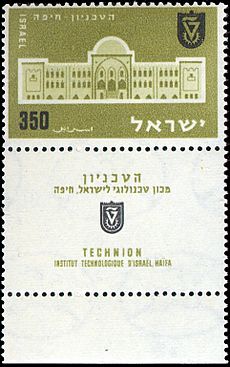
In 1948, with 680 students, Technion celebrated Israel's Declaration of Independence. The new country had many needs, and Technion started several big projects to help. In 1948, the Faculty of Electrical Engineering and the Faculty of Mechanical Engineering were set up. The Department of Aeronautical Engineering (dealing with aircraft) was created in 1949. This department is said to have laid the foundation for Israel's successful aerospace industries and Air Force.
Growing Fast and a New Campus
Yaakov Dori, who was the first Chief of Staff of the Israel Defense Forces, became President of Technion from 1951 to 1965. By 1951, the number of undergraduate students had grown to 966. The original campus in central Haifa became too small. So, Prime Minister David Ben-Gurion chose a large 300-acre site on Mount Carmel for a new campus. In 1953, the university began moving to Technion City on Mount Carmel.
In the 1950s, several new faculties (departments) were started:
- Department of Aeronautical Engineering (1953) (later renamed Faculty of Aerospace Engineering).
- Faculty of Agricultural Engineering (1953).
- Faculty of Chemical Engineering (1954).
- Faculty of Chemistry (1958).
- General Studies (1958) (later renamed Department of Humanities and Arts).
- Faculty of Industrial Engineering and Management (1958).
Years of Change and Progress
During the 1960s, Technion welcomed hundreds of students from new countries in Africa and Asia. Many Technion professors also helped other countries with technology, often through United Nations groups. Recognizing the growing need for different fields to work together, Technion created new departments. These included Biomedical Engineering, Computer Science, Applied Mathematics, and the Solid State Institute. Alexander Goldberg, a chemical engineer, was President from 1965 to 1973. In 1969, Technion started its Faculty of Medicine. This was one of the few medical schools in the world connected to a technology institute.
The 1970s in Israel saw big changes, from the difficult Yom Kippur War to the hopeful peace agreement with Egypt. Through all these changes, Technion remained important. It created technologies for Israel's safety and planned joint research projects with other countries, like those on removing salt from water (desalination) and nuclear energy.
In 1978, the Samuel Neaman Institute for Advanced Studies in Science and Technology was set up at Technion. This helped connect universities, industries, and the government even more. In 1971, the Faculty of Biology was established. Amos Horev, an Israeli Defense Forces Major-General and nuclear scientist, was President from 1973 to 1982.
The Start of Israeli High-Tech
In the 1980s, Technion's research and its many graduates helped Israel's high-tech industries grow very quickly. Technion graduates were at the forefront of new technologies like fiber optics and optoelectronics (using light in electronics). Josef Singer, an aeronautical engineer, was President from 1982 to 1986, and Max Reis, a chemical engineer, from 1986 to 1990.
In the early 1990s, many people moved to Israel from the former Soviet Union. This increased the student population from 9,000 to 10,500. Technion not only welcomed many skilled scientists and engineers from the Soviet Union but also created special companies and structures to make sure their talents could be used. Zehev Tadmor, a chemical engineer, was President from 1990 to 1998.
New centers were created where different fields worked together. Connections with industries became stronger, new study programs were developed, and the campus expanded greatly. This included building The Henry and Marilyn Taub and Family Science and Technology Center, which houses one of the world's largest computer science faculties.
In 1998, Technion's Asher Space Research Institute (ASRI) successfully launched the "Gurwin TechSat II" microsatellite. This made Technion one of only five universities in the world with a student program that designs, builds, and launches its own satellite. Amos Lapidot, the tenth Commander of the Israeli Air Force, was President from 1998 to 2001, and Yitzhak Apeloig, a pioneer in computational chemistry, from 2001 to 2009.
In 2007, Technion's important role in sharing technology in Israel was made global with the launch of its T3 Technion Technology Transfer office. Peretz Lavie, an expert in sleep disorders, was President from 2009 to 2019.
Technion has an active center for Energy Research, which aims to strengthen Israel as the world faces peak oil (when oil production reaches its highest point). It also has university-wide programs in Nanotechnology and Science, and Life Science and Engineering. Uri Sivan, a physicist, has been President since 2019.
Winning Nobel Prizes in Science
In 2004, two Technion scientists became the first Israelis to win the Nobel Prize in Science. Avram Hershko and Aaron Ciechanover, along with their colleague Irwin Rose, figured out how cells control which proteins are built up and broken down. This process is very precise. Proteins that need to be broken down get a special molecular "label." These labeled proteins are then sent to the cell's "waste disposers," called proteasomes, where they are chopped into tiny pieces and destroyed.
The label is a molecule called ubiquitin. It attaches to the protein to be destroyed and guides it to the proteasome. Just before the protein goes into the proteasome, its ubiquitin label is removed so it can be used again. This process of breaking down proteins is important for many cell functions, like cell division, repairing DNA, checking the quality of new proteins, and important parts of the immune system.
In 2011, the Nobel Prize for chemistry was given to Prof. Dan Shechtman. He won for his discovery of quasiperiodic crystals, which he called "Shechtmanite."
Amazing Technion Achievements
- Technion is one of only five universities in the world with a student program to design and build satellites. (Their first launch attempt in 1995 didn't work, but an identical copy was successfully launched in 1998).
- Scientists here used DNA strands for the first time to create a conductive wire. This wire was 1,000 times thinner than a human hair!
- The origin of a new medicine called Azilect for Parkinson's disease came from Technion. It is now sold worldwide.
- Technion is the home of "Shechtmanite" and Quasiperiodic Crystals – a new type of material. This discovery earned Prof. Dan Shechtman the Nobel Prize for Chemistry in 2011.
- The Lempel-Ziv algorithm was developed here. It's a method for compressing data that has become an international standard.
- Technion co-authored the first paper that showed how embryonic stem cells could be grown for medical use.
- More than 70% of the founders and managers in Israel's high-tech industry are Technion graduates.
- A group of Technion graduates created PHP (versions 3 through 5), a computer language used for web programming. It is installed on more than 80% of web servers around the world.
See also
- Science and technology in Israel


